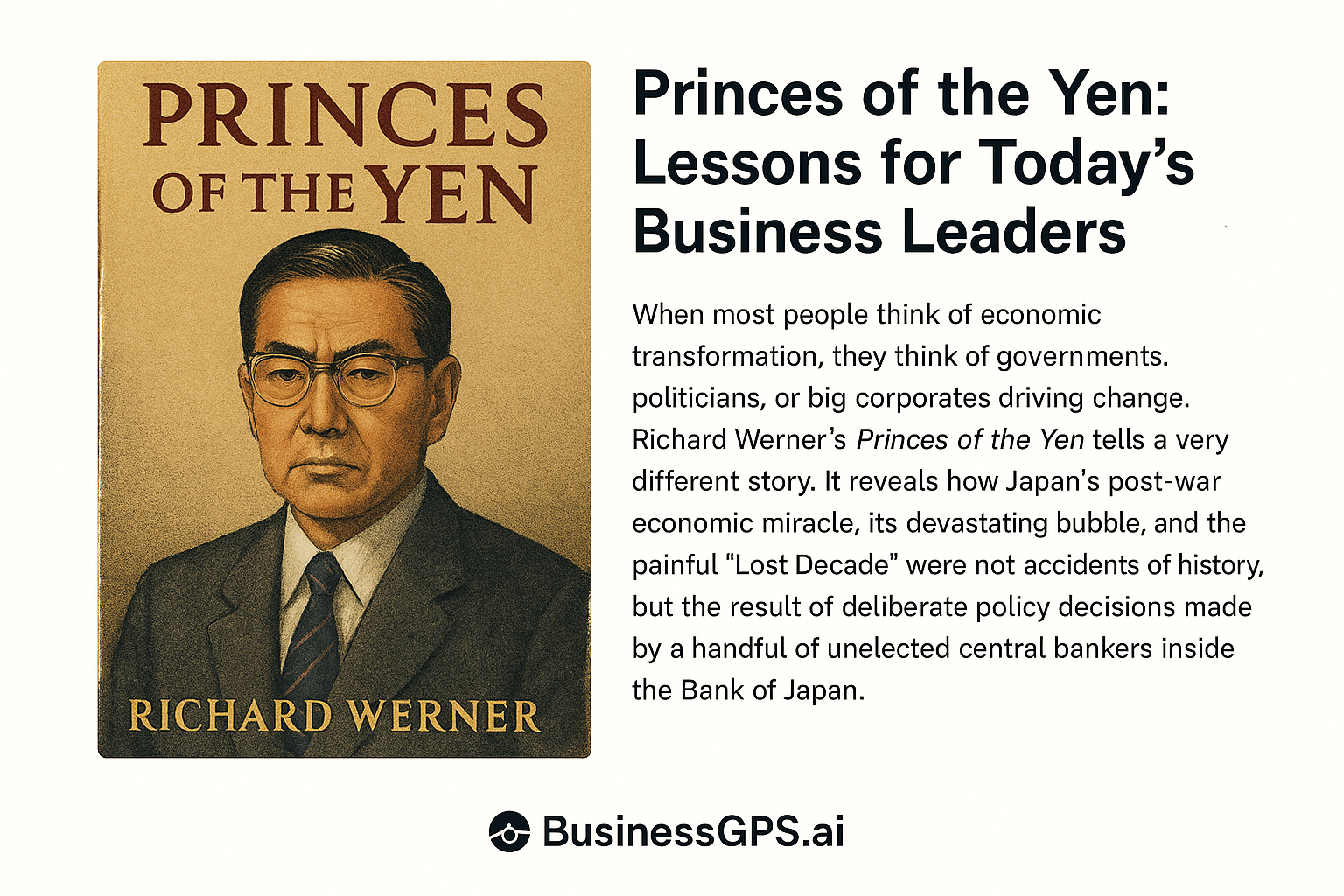
Princes of the Yen: Lessons for Today’s Business Leaders
Princes of the Yen – Central Bank Power and Business Strategy
When most people think of economic transformation, they picture governments, politicians, or big corporates driving change. But Richard Werner’s Princes of the Yen tells a very different story.
It reveals how Japan’s post-war economic miracle, its devastating bubble, and the painful “Lost Decade” were not accidents of history—but the result of deliberate policy decisions made by a handful of unelected central bankers inside the Bank of Japan.
This is a story of power, secrecy, and the hidden role of credit in shaping economies—and it carries profound lessons for today’s business leaders navigating the AI-driven transformation of global markets.
The Hidden Lever: Credit Creation
Werner dismantles a myth taught in most business schools: that interest rates and fiscal stimulus drive growth. In Japan’s case, these were sideshows.
The real driver? Credit creation—how much money banks created through lending, and to whom.
- When the BoJ wanted growth, it expanded credit to industry.
- When it wanted restructuring, it withdrew credit, starving firms of liquidity.
The consequences were vast: the 1980s real estate bubble, the crash, and the prolonged stagnation of the 1990s all stemmed from how the BoJ used this hidden tool.
Engineering a Crisis
One of Werner’s most striking claims is that Japan’s “Lost Decade” was no accident.
The BoJ could have reflated the economy by expanding credit in 1992. Instead, it tightened the taps, sterilised government interventions, and prolonged the recession.
Why? To force structural reform—dismantling Japan’s post-war “war economy” system of lifetime employment, cross-shareholdings, and bureaucratic controls—and to secure greater independence and power for the central bank.
In short, recession was used as a weapon of transformation.

The Princes Behind the Curtain
Werner introduces us to a select inner circle—figures like Sasaki, Maekawa, Mieno, and Fukui—groomed for leadership from early in their careers.
Known inside the Bank of Japan as “princes,” they shaped decades of economic history from the shadows, while politicians and even the Ministry of Finance often acted as unwitting puppets.
This dynamic is a sobering reminder: real power in economies often lies in hidden institutions and technical mechanisms.
Lessons for Business Leaders
🔍 Follow the Credit, Not Just the Headlines
GDP and interest rates distract from deeper flows of capital. Understanding how credit is created and allocated is critical to forecasting markets.
⚠️ Crises Are Rarely Accidental
Shocks and recessions can be engineered to force change. Leaders must prepare for disruption not just as random risk, but as part of deliberate transformation agendas.
🏛️ Institutions Have Agendas
Central banks, regulators, and major tech platforms act to preserve or extend their own power. Businesses that assume neutrality will be blindsided.
🔧 Transformation Requires Power Plays
Japan’s shift to U.S.-style capitalism wasn’t achieved by debate—it came through the hard medicine of recession. Real transformation often comes at high social and organizational cost.
Final Thought
Werner’s Princes of the Yen is not just a history of Japan. It is a warning:
- Economies are malleable.
- Crises can be engineered.
- The true levers of power are often invisible.
For today’s executives, the lesson is simple:
Don’t just play the game—learn who writes the rules.
👉 Call to Action
At BusinessGPS.ai, we’ve developed the O2O (Opportunity to Operations) Changing Capability to ensure your business isn’t left reacting to hidden forces, but actively shaping its own destiny.
See how Athena, our AI transformation agent, can help you prepare for the new era.





